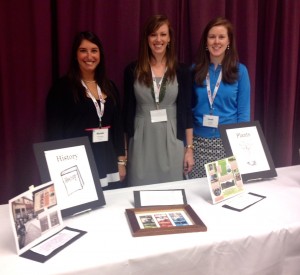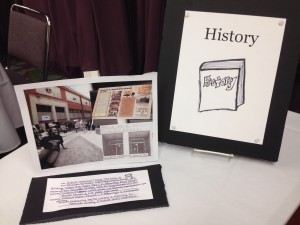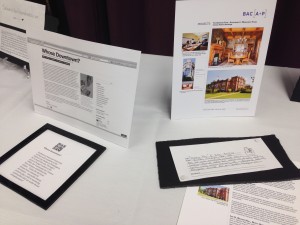Pop-up reflections from the NCPH conference
01 May 2014 – editors
First, thank you to everyone who participated in the first pop-up exhibit at the National Council on Public History conference in Monterey, “Seeds of Change: Public History and Sustainability.” The exhibit was a great success, and we are very excited about the positive responses that we received.
We created the exhibit around the conference theme of “sustainability.” Working with the NCPH program committee, we researched, created, and facilitated an exhibit that explored how public history work intersects with issues of sustainability. “Seeds of Change” served as a forum for public historians to share their experiences with sustainable practices, brainstorm creative ways that historians can promote and historicize sustainability, engage in conversations, and pose new questions.
To organize the exhibit, we used five different aspects of sustainability—history, the environment, human labor, community memory, and historic buildings—and asked participants to think about their own personal and work experiences. Our goal was to complicate the way we understand sustainability and provoke conscientious reflection about how public historians can put environmental issues into historical perspective and implement sustainable practices in their work.
During planning, it crossed our minds that bringing a physical object all the way to Monterey might be difficult, especially for those traveling from far away. We decided, therefore, that using photos or hand drawn images would be a better approach that would allow more people to participate in the exhibit. Several contributors to the pop-up museum brought photos, while a few printed documents or sketched their example of a sustainable practice. Each person wrote a label. We also asked participants to include a question, challenge, or vision for the future in order to spark conversation and engage participants at the exhibit.
The pop-up museum, both as a means of promoting the conference theme and facilitating dialogue, proved to be a valuable addition to the NCPH program. We received 30 contributions and saw more than 100 conference attendees throughout the day. Those who did not bring photographs were still able to contribute to the exhibit through our written wall discussions, which sparked vibrant conversation. Responses ranged from discussions of sustainable practices, such as composting, recycling, and upcycling, to questions about “How can we use history to raise the sustainability issue?” Other participants reflected on the practice of public history generally. For example, one participant noted that “So many ‘found’ an initiative or establish a program. How do we do the unsung work of continuing?” Agreeing, another participant declared, “Maintaining focus and commitment, decade after decade, is hard work, not glamorous at all. Yet, that’s what we all need to do, to preserve people’s stories and honor their lives.”
Several of the contributions to the exhibit demonstrated that sustainability ties directly to the work that we do as public historians. Many historians brought examples from their own work. For example, Rebekah Dobrasko contributed images of Trident Technical College in Charleston, SC, which repurposed the space of C.A. Brown High School (a 1962 segregated school) and continues to preserve stories by collecting photographs and oral histories from residents, former teachers, and alumni of the school. Dan Kerr’s “Whose Downtown?” website, a collaborative project between American University students and the residents of the Federal City Shelter in Washington, DC, chronicles the establishment of the shelter in the 1980s through a series of hunger strikes organized by the Community for Creative Non-Violence. Kerr asked participants to consider, “Can public history projects play a role in sustaining communities that are under threat of displacement?”
In their contributions, Susan M. Wood and Patti Donton each reflected on the sustainability of tribal cultures. Wood shared her experience working with Julia Bognay, a Gabrieleno Tongva elder who teaches “how her people survived in the past using native plants. She encourages tribal members, and others, to grow their own gardens for sustainability and health. Julia…reminds visitors to this living history site that if we care for the earth, it takes care of us.” Donton explained that the Salinan Tribe has gone digital, “and through our website we are able to reach a wider audience that we could never have done before.” The switch not only lowered their carbon footprint and decreased paper use but also provided a means of communication within the tribe and an educational resource for teachers.
Several contributors reflected on sustainable growing practices and the natural environment, such as the sustainability of wine production, asking “is viticulture a sustainable agricultural endeavor or an intrusion of man on the landscape?” Joy Holland Cesca and Justin Mattli of the Kona Historical Society in Hawaii explored “smart sustainability in the Kona Coffee Belt” at the Kona Coffee Living History/D. Uchida Farm. Other contributions mused on the ways in which the teaching of history can be tied to the landscape and natural resources, such as water or trees.
Some participants pondered the preservation of the built environment, such as Barbara Campagna, who shared her work creating environmentally sustainable plans for historic buildings. Timothy Adams agreed, noting, “The most sustainable building is the building that is already there.” And Priya Chhaya discussed the National Trust for Historic Preservation’s Preservation Green Lab, which “does the research to support why saving places is important.”

“Seeds of Change” curators (left to right) Nicole Orphanides, Lauren Duval, and Leah Shore. Photo used with permission from the authors.
In reflecting on the experience, we have a few recommendations for future pop-up exhibits. Some are logistical. For example, it would be useful to print the label templates on cardstock to help stabilize them in the exhibit. Alternatively, we could think through better ways to display both labels and drawings. It might also be worthwhile to consider placing additional signs around the conference in order to raise awareness about the museum or simply to move the exhibit to a more central location. Lastly, we thought about ways that we could better evaluate the exhibit, beyond our own reflections. We think that it would be a great addition to future exhibits to incorporate a survey for participants and visitors to gauge responses to the exhibit.
Beyond these recommended tweaks, however, we were very happy with the results of the museum. It was an innovative way to engage public historians in conversations about sustainability. We are honored to have been part of NCPH’s inaugural pop-up museum and are looking forward to seeing future pop-up projects at NCPH!
~ Lauren Duval, Leah Shore, and Nicole Orphanides are graduate students in the Public History Program at American University.





